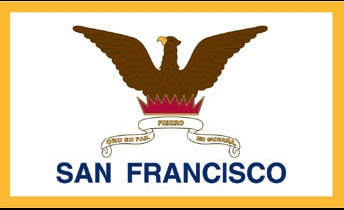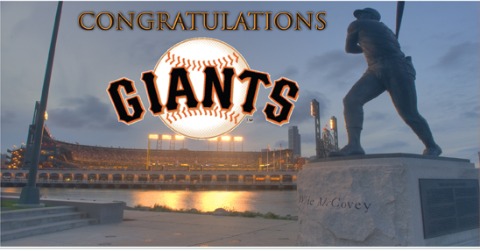Sea of Green, Sea of Orange?
So I tracked down Jon Haveman, one of the guys who authored the study predicting that America’s Cup racing will boost the Bay Area economy by $1.4 billion, and I reminded him that my friend, SF Supervisor Chris Daly, doesn’t buy it.
We’re at the tipping point of committing San Francisco to the Cup, so Jon, WTF?
“When I look at figures for a Super Bowl,” the man said, “I believe the assumptions are wildly overblown. But I think we could have understated the upside of an America’s Cup, and that was the risk we chose. At every turn, we tried to be conservative. The numbers are so big for an America’s Cup that, even when you’re conservative—even if you underestimate—the numbers are better than good.”
Haveman, of Beacon Economics, worked with Sean Randolph of the Bay Area Council Economic Institute to produce the study for the office of San Francisco Mayor (now Lt. Governor-elect) Gavin Newsom, whose people on Tuesday will begin the dance with the Board of Supervisors, working toward a binding agreement between the city and America’s Cup organizers. The prospect sounded a bit more dynamic and exciting when I read it via Phillip Matier and Andrew Ross, who write a political column for the San Francisco Chronicle—they’re way-doggies better connected at City Hall than I am—but I have it that the city and the team are still talking, still in negotiations so we’re not . . . there . . . yet.
Things sound increasingly hopeful for AC-N-SF, and an announcement can’t come soon enough for frustrated would-be challengers, or even frustrated U.S. candidates for the defense. Nobody wants to be quoted, but the back-channel talk boils down to something like: If you’re not a billionaire who can tell one of your secretaries to cut a check for a Cup campaign, how do you get traction? It’s like mountain climbing on gravel. How can you make a successful sponsorship proposal now without more to go on, and how can you keep waiting when you’re supposed to have a 72-foot catamaran on the water in 2012?
Well, you can’t. So let’s hope we’re finally getting somewhere. I figure the Defender is as eager as anyone else to get on with dragging the America’s Cup kicking and screaming into the 21st century.
Artemis is in, of course. Torbjörn Törnqvist gave his secretary the word to cut the check, and the team announced on Monday as the fourth America’s Cup challenger ever to carry the colors of the Royal Swedish Yacht Club. Names you know include CEO Paul Cayard, helmsman Terry Hutchinson—the man with a seemingly endless supply of silver-frame Kores—and designer Juan Kouyoumdjian.
But, getting to this sea of green, sea of orange theme, political writers Matier & Ross also tell us that there has been some backroom arm wrestling over the Pier 50 site where America’s Cup Defender Larry Ellison wants to base the teams. Apparently the owners of the San Francisco Giants–AT&T Park is a prized tenant of the Port of San Francisco–have been wanting to expand their sports/entertainment franchise into new areas, and they too have had an eye on that broad-shouldered facility so close across the waters of McCovey Cove.
San Francisco for the past week has been truly a sea of orange.
 Photo Courtesy Port of San Francisco
Photo Courtesy Port of San Francisco
Meanwhile, the Port of San Francisco has such enormous needs that it can’t hope to meet all of those needs out of either an America’s Cup match or an expanded Giants sports franchise at Pier 50, so it has to get as much as it can. It’s not as though the southern waterfront piers are going to rehabilitate themselves.
(I note that a Giants representative showed up at City Hall in October to support the America’s Cup before the Land Use subcommittee of the Board of Supes.)
I’m in the habit of telling people that an America’s Cup match on San Francisco Bay will be highly disruptive, and absolutely wonderful. The report by Haveman and Randolph has a different way of saying the same thing: “Even though there is some potential for disruption, San Francisco’s economy has long focused on and benefited significantly from tourism, including large-scale events. The city’s residents have tussled with the effects of tourism for a very long time, and most sincerely hope to for a very long time yet to come.
GENERATING NUMBERS
The study, which you can read in its entirety HERE, took two months, June and July, and had to make assumptions in the absence of certainties about the number of teams that will be involved and how long the teams might actually stay in San Francisco.
“It was complicated,”Haveman said, “because San Francisco is so different from previous venues. It’s a larger tourist attraction than Valencia. It’s a bigger attraction than Auckland or even San Diego, but we drew heavily on Valencia as a guide to how many visitors to expect, and we drew heavily on Fleet Week as a guide to how many local spectators to expect. That said, the participants [with their teams and families and need for services] are the primary drivers of benefits to the community.”
Conspicuous differences from past practice?
“In Valencia, each team built its own hospitality suite,” Haveman said. “I’m told that is simply not in the plans here, that Cup management will supply a hospitality suite. There are significant space constraints on the San Francisco cityfront. In that regard it’s not like Valencia. There’s plenty of space in Alameda, of course, but then you’ve separated the teams from the public.”
The report is too big a bite for most readers, but here is an excerpt that illustrates the methods employed:
The benefits to San Francisco’s visitor industry would come in several forms:
Hotels. As of October 2009, there were 32,976 hotel rooms available in San Francisco. During the likely months of the America’s Cup, June through September, occupancy rates in the city are at their very highest. Between 2005 and 2009, occupancy rates averaged roughly 85%. This implies the availability of some 4,800 rooms for America’s Cup spectators. Using typical room occupancy data of 1.77 individuals per room, this suggests the availability of hotel lodging for roughly 8,500 spectators on any given night during the America’s Cup. Over the course of three months, assuming full occupancy, this suggests that at an average room rate of $180, the hotel industry could potentially receive an addition to normal revenues of up to $77.8 million.
This calculation appears to provide an upper bound on the addition to revenues as it assumes that all hotel rooms would be occupied. However, it is frequently the case that room rates increase significantly during major events in the city. During periods of peak occupancy, such as special events, hotels are often able to command rates that are significantly higher than during less busy times of the year. Although the extent to which rates may increase is uncertain, the calculation above nonetheless provides an indication of the type of benefit that local hotels stand to gain. It should be noted that if the America’s Cup were to run for three months, this would imply the accommodation of an additional 764,848 visitor days. The number of additional visitor days in Valencia in 2007 was significantly more than this, suggesting that hotels will likely have very high occupancy rates during the event and that the estimate above may not be too far off the mark.
That the available hotel rooms may be insufficient to accommodate all of the potential Cup spectators suggests that many would be encouraged to find lodging outside of the city or in private homes or residences. Both are quite probable, with hotels and inns in the North, East, and South Bay all likely benefitting from the influx of spectators.Another possibility for providing additional lodging is the use of cruise ships as floating hotels, a concept that has been implemented at other large-scale events, including previous America’s Cup races and the Sydney and Barcelona Olympics. Although dock space is limited at the Port of San Francisco, smaller cruise ships can accommodate 900 to 1,000 guests, and larger vessels up to 5,400. Adding one or two cruise ships could absorb a significant portion, if not all, of the excess demand for hotel space in San Francisco. The race would occur during the shoulder season, as vessels transition from summer service in Alaska (mid-May to mid-September) to winter service in the Caribbean. While some ships are based in San Francisco, most are based in Vancouver. It is therefore feasible for ships heading south from Vancouver to stop in San Francisco to address America’s Cup demand. As passenger counts drop off toward the end of Alaska’s high season (around mid-August), attractive passenger loads in San Francisco could induce cruise lines to reposition their vessels earlier (in late August or early September) and stay longer. Vessels unable to be accommodated at San Francisco’s cruise terminal could potentially berth at alternative space on the waterfront, or anchor out on the Bay with shore access provided by tender. Typically, ships serving the market in this way would be chartered for the purpose.
